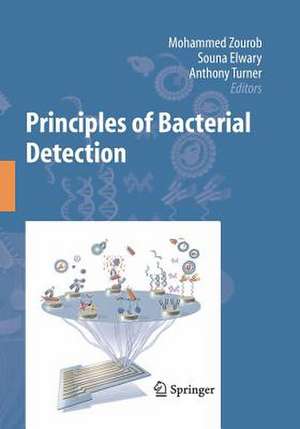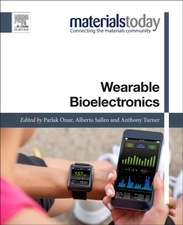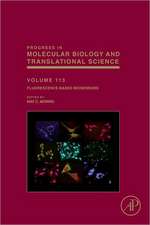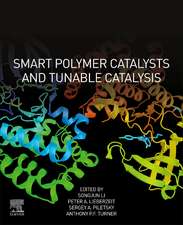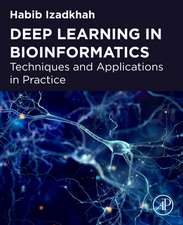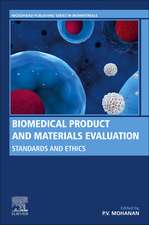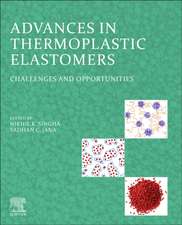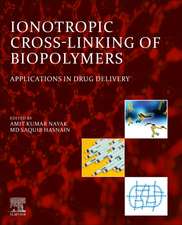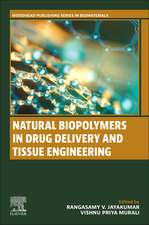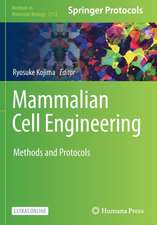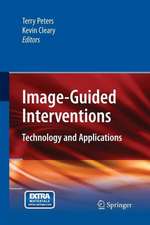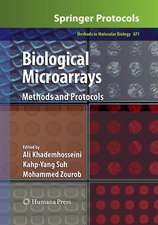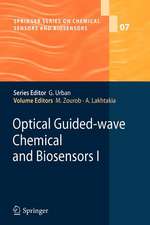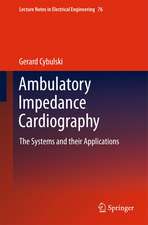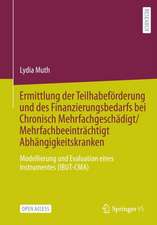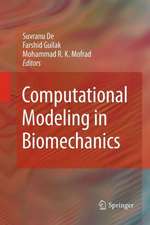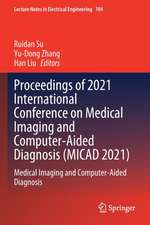Principles of Bacterial Detection: Biosensors, Recognition Receptors and Microsystems
Editat de Mohammed Zourob, Sauna Elwary, Anthony P. F. Turneren Limba Engleză Paperback – 23 aug 2016
| Toate formatele și edițiile | Preț | Express |
|---|---|---|
| Paperback (1) | 1683.96 lei 43-57 zile | |
| Springer – 23 aug 2016 | 1683.96 lei 43-57 zile | |
| Hardback (1) | 1665.25 lei 43-57 zile | |
| Springer – 30 sep 2008 | 1665.25 lei 43-57 zile |
Preț: 1683.96 lei
Preț vechi: 1772.59 lei
-5% Nou
Puncte Express: 2526
Preț estimativ în valută:
322.22€ • 337.33$ • 266.62£
322.22€ • 337.33$ • 266.62£
Carte tipărită la comandă
Livrare economică 07-21 aprilie
Preluare comenzi: 021 569.72.76
Specificații
ISBN-13: 9781493950652
ISBN-10: 1493950657
Pagini: 970
Ilustrații: XXXII, 970 p.
Dimensiuni: 178 x 254 x 59 mm
Greutate: 2.53 kg
Ediția:Softcover reprint of the original 1st ed. 2008
Editura: Springer
Colecția Springer
Locul publicării:New York, NY, United States
ISBN-10: 1493950657
Pagini: 970
Ilustrații: XXXII, 970 p.
Dimensiuni: 178 x 254 x 59 mm
Greutate: 2.53 kg
Ediția:Softcover reprint of the original 1st ed. 2008
Editura: Springer
Colecția Springer
Locul publicării:New York, NY, United States
Descriere
Principles of Bacterial Detection: Biosensors, Recognition Receptors and Microsystems will cover the up-to-date biosensor technologies used for the detection of bacteria. Written by the world's most renowned and learned scientists each in their own area of expertise, Principles of Bacterial Detection: Biosensors, Recognition Receptors and Microsystems is the first title to cover this expanding research field.
Cuprins
Introduction to Pathogenic Bacteria-Tracey Elizabeth Love and Barbara Jones.- Sample Preparation: An Essential Prerequisite for High-Quality Bacteria Detection-Jan W. Kretzer, Manfred Biebl and Stefan Miller.- Detection of Bacterial Pathogens in Different Matrices: Current Practices and Challenges-Ahmed E. Yousef.- Overview of Rapid Microbiological Methods-Jeanne Moldenhauer.- Surface Plasmon Resonance (SPR) Sensors for the Detection of Bacterial Pathogens-Allen D. Taylor, Jon Ladd, Jiˇrà Homola and Shaoyi Jiang.- Bacterial Detection Using Evanescent Wave-Based Fluorescent Biosensors-Kim E. Sapsford and Lisa C. Shriver-Lake.- Fiber Optic Biosensors for Bacterial Detection-Ryan B. Hayman.- Integrated Deep-Probe Optical Waveguides for Label Free Bacterial Detection-Mohammed Zourob, Nina Skivesen, Robert Horvath, Stephan Mohr, Martin B. McDonnell and Nicholas J. Goddard.- Interferometric Biosensors-Daniel P. Campbell.- Luminescence Techniques for the Detection of Bacterial Pathogens-Leigh Farris, Mussie Y. Habteselassie, Lynda Perry, S. Yanyun Chen, Ronald Turco, Brad Reuhs and Bruce Applegate.- Porous and Planar Silicon Sensors-Charles R. Mace and Benjamin L. Miller.- Acoustic Wave (TSM) Biosensors: Weighing Bacteria-Eric Olsen, Arnold Vainrub and Vitaly Vodyanoy.- Amperometric Biosensors for Pathogenic Bacteria Detection-Ilaria Palchetti and Marco Mascini.- Microbial Genetic Analysis Based on Field Effect Transistors-Yuji Miyahara, Toshiya Sakata and Akira Matsumoto.- Impedance-Based Biosensors for Pathogen Detection-Xavier Muñoz-Berbel, Neus Godino, Olivier Laczka, Eva Baldrich, Francesc Xavier Muñoz and Fco. Javier Del Campo.- Label-Free Microbial Biosensors Using Molecular Nanowire Transducers-Evangelyn Alocilja and Zarini Muhammad-Tahir.- Magnetic Techniques for Rapid Detection of Pathogens-Yousef Haik, Reyad Sawafta, Irina Ciubotaru, Ahmad Qablan, Ee Lim Tan and Keat Ghee Ong.- Cantilever Sensors for Pathogen Detection-Raj Mutharasan.-Detection and Viability Assessment of Endospore-Forming Pathogens-Adrian Ponce, Stephanie A. Connon and Pun To Yung.- Label-Free Fingerprinting of Pathogens by Raman Spectroscopy Techniques-Ann E. Grow.- Antibodies and Immunoassays for Detection of Bacterial Pathogens-Padmapriya P. Banada and Arun. K. Bhunia.- Rapid Nucleic Acid-Based Diagnostics Methods for the Detection of Bacterial Pathogens-Barry Glynn.- Oligonucleotide and DNA Microarrays: Versatile Tools for Rapid Bacterial Diagnostics-Tanja Kostic, Patrice Francois, Levente Bodrossy and Jacques Schrenzel.- Pathogenic Bacterial Sensors Based on Carbohydrates as Sensing Elements-Haiying Liu.- Aptamers and Their Potential as Recognition Elements for the Detection of Bacteria-Casey C. Fowler, Naveen K. Navani, Eric D. Brown and Yingfu Li.- Protein Microarray Technologies for Detection and Identification of Bacterial and Protein Analytes-Christer Wingren and Carl AK Borrebaeck.- Bacteriophage: Powerful Tools for the Detection of Bacterial Pathogens-Mathias Schmelcher and Martin J. Loessner.- Phage Display Methods for Detection of Bacterial Pathogens-Paul A. Gulig, Julio L. Martin, Harald G. Messer, Beverly L. Deffense and Crystal J. Harpley.- Molecular Imprinted Polymers for Biorecognition of Bioagents-Keith Warriner, Edward P.C. Lai, Azadeh Namvar, Daniel M. Hawkins and Subrayal M. Reddy.- Microfluidics-Based Lysis of Bacteria and Spores for Detection and Analysis-Ning Bao and Chang Lu.- Detection of Pathogens by On-Chip PCR-Pierre-Alain Auroux.- Micro- and Nanopatterning for Bacteria- and Virus-Based Biosensing Applications-David Morrison, Kahp Y. Suh and Ali Khademhosseini.- Microfabricated Flow Cytometers for Bacterial Detection-Sung-Yi Yang and Gwo-Bin Lee.- Bacterial Concentration, Separation and Analysis by Dielectrophoresis-Michael Pycraft Hughes and Kai Friedrich Hoettges.- Ultrasonic Microsystems for Bacterial Cell Manipulation-Martyn Hill and Nicholas R. Harris.- Recent Advances in Real-Time Mass Spect
Textul de pe ultima copertă
Principles of Bacterial Detection: Biosensors, Recognition Receptors and Microsystems presents a significant and up-to-date review of various integrated approaches for bacterial detection. Distinguished engineers and scientists from key institutions worldwide have contributed chapters that provide a deep analysis of their particular subject; at the same time, each topic is framed within the context of this integrated approach. This work is a comprehensive approach to bacterial detection requiring a thorough knowledge of the subject and an effective integration of other disciplines in order to appropriately convey the state-of-the-art fundamentals and applications of the involved disciplines.
The book consists of four parts:
The first part provides an introduction to pathogenic bacteria and sampling techniques and an overview of the rapid microbiological methods.
The second part describes the different transducers used for the detection of bacteria. It covers the theory behind each technique and provides a state-of-the-art review of all the new technologies used for the detection of bacteria in detail. Strategies and future prospects are suggested at the end of each chapter for developing future technologies to achieve a better sensitivity and swifter detection of bacteria.
The third part gives an account of the different recognition receptors used in the various methods for the detection of bacteria. It describes in detail the use of immunoassays, nucleic acids, oligonucleotide microarrays, carbohydrates, aptamers, protein microarrays, bacteriophages, phage displays and molecular imprinted polymers as recognition elements.
The fourth part covers the microsystems used for detection/identification and bacterial manipulation such as bacteria lysis and PCR in microfluidics, dielectrophoresis, ultrasonic manipulation techniques and mass spectrometry techniques.
Students and researchers who need a solid foundation or reference and practitioners interested in discovering more about the state-of-the-art methods of bacterial detection will find this book invaluable. This book is directed at academics and undergraduate and postgraduate students who work in areas related to bacterial detection. It may also serve as an important reference for professionals working in different fields, including biomedical science, physical science, microsystems engineering, nanotechnology, veterinary science, food quality assurance, bioterrorism and security as well as health surveillance.
The book consists of four parts:
The first part provides an introduction to pathogenic bacteria and sampling techniques and an overview of the rapid microbiological methods.
The second part describes the different transducers used for the detection of bacteria. It covers the theory behind each technique and provides a state-of-the-art review of all the new technologies used for the detection of bacteria in detail. Strategies and future prospects are suggested at the end of each chapter for developing future technologies to achieve a better sensitivity and swifter detection of bacteria.
The third part gives an account of the different recognition receptors used in the various methods for the detection of bacteria. It describes in detail the use of immunoassays, nucleic acids, oligonucleotide microarrays, carbohydrates, aptamers, protein microarrays, bacteriophages, phage displays and molecular imprinted polymers as recognition elements.
The fourth part covers the microsystems used for detection/identification and bacterial manipulation such as bacteria lysis and PCR in microfluidics, dielectrophoresis, ultrasonic manipulation techniques and mass spectrometry techniques.
Students and researchers who need a solid foundation or reference and practitioners interested in discovering more about the state-of-the-art methods of bacterial detection will find this book invaluable. This book is directed at academics and undergraduate and postgraduate students who work in areas related to bacterial detection. It may also serve as an important reference for professionals working in different fields, including biomedical science, physical science, microsystems engineering, nanotechnology, veterinary science, food quality assurance, bioterrorism and security as well as health surveillance.
Caracteristici
Will offer practical comparison of technologies with standardization of chapter organization for easy reference
First title to cover the expanding research field of biosensor technologies used for the detection of bacteria
First title to cover the expanding research field of biosensor technologies used for the detection of bacteria
